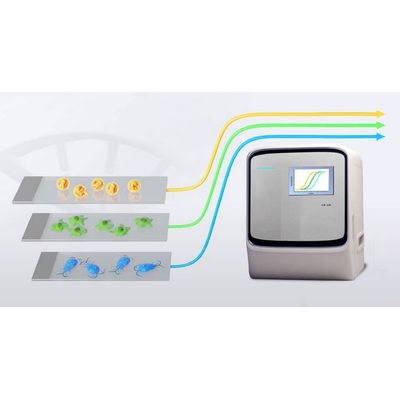

- Home
- Companies
- Genetic Signatures Ltd.
- Products
- Genetic - Molecular Ova and Parasite ...

Genetic - Molecular Ova and Parasite Screening System
In the United States (US), gastrointestinal (GI) protozoan parasites are a significant healthcare burden, with more than 350 million cases of acute GI infections annually. Globally, protozoan infections are the leading cause of mortality of children under five years old.1,2 Hence, the importance of rapid and accurate diagnosis and treatment is essential for decreasing the significant burden of GI infections. The Center for Disease Control and Prevention (CDC) recorded a steady increase in reported GI protozoan outbreaks in the US over the past 12 years until 2020 (refer to the chart below). At this point, COVID-19 restrictions significantly decreased outbreaks due to reduced mobility, and decreased local and international travel. However, now that restrictions have lifted, reported weekly parasite infections from the National Notifiable Diseases Surveillance System (NNDS) indicate a lift in reported cases in early 2022.
There is increasing evidence and recognition of numerous parasites that cause symptoms of gastroenteritis.3,4,5 Whilst some are more common, there are other emerging protozoan infections that are becoming of more interest to clinicians. The table below summarises 8 clinically relevant GI protozoa that have significant infection rates in the US, and which can be screened efficiently by molecular ova and parasite methodology and compliment traditional methods, such as stool ova and parasite microscopic exams.
Giardiasis is one of the leading GI parasitic infections, regularly associated with waterborne parasite outbreaks in summer months. Infection is underreported at 20.000 cases in the US each year, with real cases estimated at 1-2 million cases in the US alone.8,7 Giardia infection rarely cause death in the US, however, 4,600 people are hospitalized with giardiasis each year.8
There are more than 2.9 million cases of cryptosporidiosis recorded each year in children aged < 24 months in sub-Saharan Africa alone.9 In the US, an estimated 748,000 cryptosporidiosis cases occur each year. Higher transmission is recorded in summer months with increased recreational water use.10
Amebiasis results in 100,000 human deaths annually on a global scale.9 In the US, incidence of amebiasis is low and mostly seen in returning travelers or immigrants from developing countries. In the US, amebiasis-related deaths still occur occasionally, at around five deaths per year. 11
Between 2018 to 2021 there have been roughly 6,000 domestically-acquired cases of cyclosporiasis in the US, though like other GI parasitic infections, cases are thought to be underreported.12 Outbreaks in the US have been linked to ingestion of contaminated food and water. Infection is also associated with foreign travel.
D. fragilis was identified in 0.5% of all stool samples examined in a large US study, and the prevalence is as high as 20% to 50% in selected populations,12 In some areas of the world, the prevalence of dientamoebiasis exceeds giardiasis. 13
B. hominis is the predominant parasite found in human stool samples, with a higher prevalence in developing countries (50-60%) than developed countries (about 10% or less).14 It has been suggested that B. hominis may be a commensal organism that becomes pathogenic when the host is immunosuppressed, malnourished or has other infections.15
(Enterocytozoon bieneusil
Encephalitozoon intestinalis)
Microsporidia are increasingly recognized as opportunistic infectious agents worldwide.16 In developed countries prevalence rates for enteric microsporidiosis in HIV-seropositive persons with diarrhea has been seen to range from 2% to 78%.17,18
Genetic Signatures real-time PCR assays provide detection for over 30 bacterial, viral and protozoan targets. For more information about other targets in our GI product range, click here.
For more information on the regulatory status in your region, contact our team at northamerica@geneticsignature.com
Multiplex PCR assays for detecting ova and parasites have many advantages compared to traditional testing, such as stool ova and parasite microscopic exams
- Provides a faster, automated process to improve laboratory throughput
- Rapid high throughput screening for the majority of the clinically relevant parasites in the one sample
- Allows experienced FTEs to be redeployed to support other laboratory testing needs
- Increased sensitivity and specificity to support improved positive detection rate21,22,23
- Supports the detection of parasites not easily detected by traditional methods (e.g. Cyclospora spp.)
- Molecular solutions are more accurate compared to stool ova and parasite microscopic exams which requires highly trained staff and human judgment
- Molecular solutions are easy to use and require minimal technical experience
- Improves reporting and surveillance for epidemiological studies
- Improves turn around time (TAT) to support clinicians to provide rapid and appropriate administration of anti-protozoal therapies to improve patient management
- Reduced downstream costs associated with pathology services or hospitalisation24,25
Hear Dr Marc Couturier discuss how molecular ova and parasite testing has supported his laboratory in the on-demand webinar: The burden of gastrointestinal parasites and advances in ova and parasite diagnostic screening. Click here
Molecular ova and parasite testing is an application of real-time multiplex PCR developed exclusively by Genetic Signatures, driven by our proprietary 3baseTM technology. This technology improves the efficiency, sensitivity and specificity of multiplex PCR. Learn more about the advantages of 3baseTM here.
The EasyScreen™ Enteric Protozoan Extended Detection Kit allows patient samples to be tested for 8 clinically relevant gastrointestinal protozoa pathogens at one time. Using the process of PCR, unique target genes for each organism are detected, outlined in the diagram below.
Note: Genetic Signatures’ EasyScreenTM Enteric Protozoan Detection Kit is currently for Investigational Use Only in the United States. Analytical and performance characteristics are not established for Analyte Specific Reagents (ASRs). Contact us for more information on regulatory status of our products in your region. When using our products always use the label and follow the directions for use.
